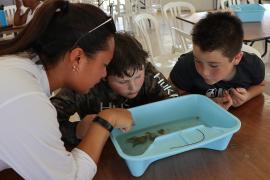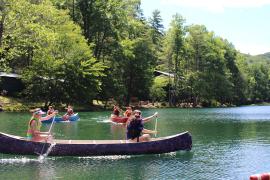Summer camp ventilation historically has been very easy — just open up the windows and let the fresh summer air in. Unless your summer camp is in a warm location, the use of fans or ventilation has likely not been in the forefront of your mind. COVID-19 has introduced new challenges to the camp industry. Infection stems from a respiratory virus that is mostly spread through your mouth or nose. Coughing, sneezing, talking, or even singing can expel respiratory droplets, which can contain the virus if you are infected. Transmission is more likely though the air than from a surface.
Although it is highly recommended to do so, many camps do not have the resources to hire a ventilation engineer to inspect and give recommendations regarding your facilities.
Fortunately, there are many affordable solutions available that can easily add proper fresh air and indoor air exhaust to most spaces. Ventilation comes in many forms, but the most affordable way to implement these without a full HVAC installation are the use of portable-type fans and portable air filters (fans with a power cord) or permanently installed fans, such as those seen in bathroom exhaust fans and air filters. Other unique solutions could include the use of whole-house-style attic fans that draw air into a space through open windows and exhausts through an attic of a structure. Whatever path you take, be sure to follow recommendations from the Centers for Disease Control and Prevention (CDC), Environmental Protection Agency (EPA), and state and local authorities[i]. Remember building permits may be required.
Electrical safety must be considered in all situations when installing electrical appliances. Installing fans with manufacturer-supplied hanging brackets to keep fans off the floor and out of pedestrian traffic can prevent accidental tip-overs and eliminate hazards such as electrical fans and cords coming in contact with water on floors. Proper hanging installation also takes away the ability for untrained personnel to move fans to locations that do not properly ventilate. Also highly recommended is selecting outdoor rated fans for any application outdoors or in areas that could come in contact with rain. Although in many cases these products are more expensive than widely available inexpensive fans, the small extra cost will more than offset the potential risk.
Real World Examples
A thorough COVID-19 prevention strategy must include a good ventilation strategy in addition to testing, sanitation, and a host of other factors[ii]. The locations that camps could focus on include indoor sleeping spaces, common areas, as well as staff work areas such as kitchens and administration buildings. Normal ventilation rates were established to control CO2, bio-effluents, moisture, and outgassing of building materials (ex: formaldehyde). COVID-19 requires something more, and the guidance is still being developed. Ventilation is part of a strategy to reduce the concentration rate of viable virus, but if the space is occupied by an infected person, it can't be completely eliminated.
Ventilation strategy
The first step is to be sure all existing exhaust fans are functional and operating (restrooms and cooking areas). Consider replacing inoperative fans with Energy Star models. Then, if you have an HVAC system, a fan-powered fresh air unit as part of your heating and air conditioning central system helps dilute contaminants. Installing a better-rated (Higher MERV number up to about 13) air filter in your central air system helps. The better the air filter rating, the harder it is for air to be pulled through them. This will affect the system's performance and longevity, so consult your HVAC professional about your system. Next, calculate the amount of ventilation air required based on the methods and examples below. Decide on the exhaust and intake locations and whether or not you want to include HEPA air purifiers as part of the strategy.
HEPA air purifiers are the gold standard for airborne particle capture (min 99.97 percent efficiency) and are especially useful if you are ventilating a conditioned space or perhaps you have to reduce the ventilation rate due to inclement weather. To be effective in this application, they need to be powerful commercial units with strong fans and preferably multiple stages of filtration (like the products used for mold remediation). Small residential units will only be effective in small spaces (offices, bedrooms). Commercial units will usually be louder. With HEPA air purifiers you can subtract the airflow of the purifier directly from the ventilation air you calculate as long as it runs at the same time.
The source material referenced in the below examples is taken from The American Society of Heating, Refrigerating, and Air-Conditioning Engineers (ASHRAE), CDC, and EPA. Links are included in the end notes.
1. Normal occupancy spaces
ASHRAE has set forth standards for ventilation guidelines for typical occupancies and we can use this data for similar uses in camps and apply a safety factor to account for the still developing science. The general calculation is based on the number of occupants and the square footage of the space. There are other methods but with social distancing and reduced occupancy this method will result in a lower value.
Typical uses:[iii]
| Gym | 20 CFM/Person + 0.06 CFM/ft2 of floor space |
| Classroom | 10 CFM/Person + 0.12 CFM/ft2 of floor space |
| Dining Rooms | 7.5 CFM/Person + 0.18 CFM/ft2 of floor space |
| Spectator Areas | 7.5 CFM/Person + 0.06 CFM/ft2 of floor space |
| Multi-Purpose Assembly | 5 CFM/Person + 0.06 CFM/ft2 of floor space |
| Barracks | 5 CFM/Person + 0.06 CFM/ft2 of floor space |
So in a sleeping area with eight occupants that is 60' x 20' (1,200 ft2):
- We will use barracks as most similar, so
- (8 people x 5 CFM/Person) + (1,200 ft2 x 0.06 CFM/ft2 of floor space) = 112 CFM
- 112 CFM x 4 (Our recommended safety factor) = at least 448 CFM
Note: This is a pretty small number and easily done with window fans, ducted whole house fans, gable fans, inline fans, and many other inexpensive options.
Directional considerations:
If the beds are against the walls, open the windows, and locate the occupant's head near the wall and the exhaust duct in the center of the room. If using window fans, they should exhaust air on opposite walls with other open windows for supply air. Try to distribute the fresh air evenly. Don't move air from the breathing zone of one person into the breathing zone of another person. If the room layout doesn't allow well-distributed clean air, consider adding circulating fans to distribute and mix fresh air throughout the space, or HEPA air purifiers. You can visualize the flow pattern by moving a theatrical smoke machine near the fresh air intakes and watching where the smoke moves (not a professional model — and don't get carried away).
2. Nurses Area/Isolation Area
Special attention to ventilation should be paid to areas that potential COVID-19 cases may be housed. The recommended ventilation rate for an isolation area is 12 ACH (air changes /per hour[iv]). (Sorry — another calculation)
CFM = W x L x H x ACH/60
Example room size = 10' W x 12' Long x 9' High x 12 ACH/60 = 216 CFM
In this case, there is no need for an additional factor, as infectious disease was considered when the ventilation rate was determined. It's based on room volume and not the number of occupants. Be sure the exhaust outlet is away (25 feet in this case) from intake locations on the outside of the building.
Directional considerations:
The person's head should be located near the exhaust duct with the supply air at the opposite side of the room.
In Conclusion
Fortunately, the investments made in ventilation for COVID-19 prevention can also benefit your campers in the long term. Many of the same strategies used for COVID-19 prevention can also benefit campers that are allergy sufferers (HEPA air purifiers) and make kids' time at camp more comfortable. Many of these ventilation strategies are relatively low cost and low maintenance and can be installed in an afternoon in one location.
We recommend that you consult a local HVAC licensed engineer (not an installer) and ensure that all ventilation is installed according to local electrical codes and regulations.
This blog post was provided by Ventamatic.
John C. Fox, P.E.
VP Engineering at Ventamatic, Ltd
President Healthy Air Research and Certification Authority
Thomas L Murrell
VP Indoor Air Quality QuFresh Division at Ventamatic Ltd
ASHRAE Member
International Code Council Member in Building Safety and Preferred Provider
North America Technical Excellence Approved Trainer for Ventilation
Air Conditioning Contractors of America and Indoor Air Quality Association Member
References
Discloser: Ventamatic is a proud ACA Business Affiliate. It's website usfanco.com can provide ACA members with most of their needs mentioned in this post. Use the coupon code ACA2021 for a 10% discount. You can call us at 312-480-9776.
[i] protect-us.mimecast.com/s/DxAKCYEqnxTLA63lf0t5s9?domain=cdc.gov
[ii] cdc.gov/coronavirus/2019-ncov/community/schools-childcare/operation-strategy.html
[iii] ashrae.iwrapper.com/ASHRAE_PREVIEW_ONLY_STANDARDS/STD_62.1_2019
[iv] cdc.gov/infectioncontrol/pdf/guidelines/environmental-guidelines-P.pdf
[v] ashrae.org/technical-resources/reopening-of-schools-and-universities
[vi] epa.gov/coronavirus/ventilation-and-coronavirus-covid-19
[vii] epa.gov/coronavirus/air-cleaners-hvac-filters-and-coronavirus-covid-19
Periodically, the American Camp Association (ACA) makes timely and relevant information about products and services available to its members so they can make informed decisions for their camps. However, the ACA does not endorse products, services, or companies.
The views and opinions expressed by contributors are their own and do not necessarily reflect the views of the American Camp Association or ACA employees.




